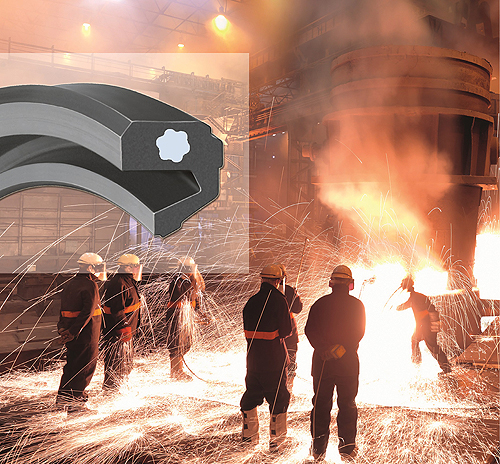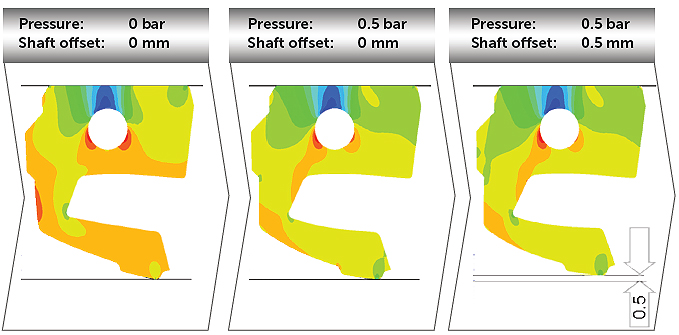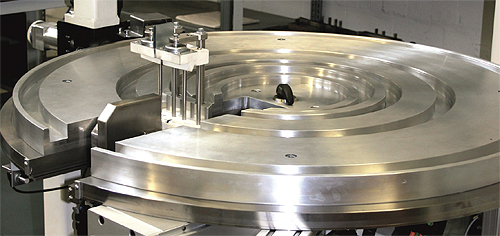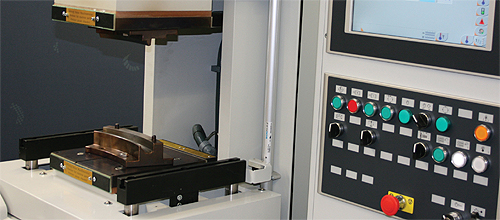New material for radial shaft seals increases uptime
 The key element
Compared to other applications in heavy industry, the expectations for longevity are low in steel plants. This was the driving factor behind the new design—the springless seal lip. In the project’s launch phase, however, it became clear that this kind of seal design could not be achieved with known materials. The development of a new elastomer material was needed.
The key element
Compared to other applications in heavy industry, the expectations for longevity are low in steel plants. This was the driving factor behind the new design—the springless seal lip. In the project’s launch phase, however, it became clear that this kind of seal design could not be achieved with known materials. The development of a new elastomer material was needed.
 Pretensioning elements are traditionally used at the seal lip of radial shaft sealing rings. They are either round springs integrated into slots, formed leaf springs or combinations of the two. The main reason for spring pretensioning is that current materials fatigue too quickly to produce their own stressing force over a long time period. Due to wear on the seal edge, it must also be continuously repositioned. The seal edge needs sufficient contact and pressure on the counter face to achieve the required sealing effect even with slight shaft eccentricity. In addition, this has to occur over the equipment’s entire operating life.
Elastomer materials’ compression set is the most important variable affecting the potential for long-lasting elasticity. This material property is a measure of how elastomers behave under long-term, constant deformation, under pressure and during subsequent relaxation. To achieve these material characteristics, it was essential to reduce this value to a minimum. The goal was to guarantee a high material elasticity over the required maximum lifespan of 8,000 operating hours. The developers could not allow other material qualities, including high wear resistance and joint strength, to be influenced by a change in the formula. There are already tried and tested formulas for the maximum wear resistance.
The newly developed elastomer material walks this tightrope with good elastic capacity and excellent wear behavior. The material’s good joining capacity also provides the desired dimensional flexibility during the manufacturing of the sealing rings.
Self-retaining ability in the installation space
As retaining elements, metal rings give seals a firm fit in the installation space but with the disadvantages previously mentioned. A self-retaining fit into the installation space is part of the specifications, even if no cover or flange is used. Once installed, the operation in the work rolls is nearly pressureless. As a result, the required retaining forces are limited.
Pretensioning elements are traditionally used at the seal lip of radial shaft sealing rings. They are either round springs integrated into slots, formed leaf springs or combinations of the two. The main reason for spring pretensioning is that current materials fatigue too quickly to produce their own stressing force over a long time period. Due to wear on the seal edge, it must also be continuously repositioned. The seal edge needs sufficient contact and pressure on the counter face to achieve the required sealing effect even with slight shaft eccentricity. In addition, this has to occur over the equipment’s entire operating life.
Elastomer materials’ compression set is the most important variable affecting the potential for long-lasting elasticity. This material property is a measure of how elastomers behave under long-term, constant deformation, under pressure and during subsequent relaxation. To achieve these material characteristics, it was essential to reduce this value to a minimum. The goal was to guarantee a high material elasticity over the required maximum lifespan of 8,000 operating hours. The developers could not allow other material qualities, including high wear resistance and joint strength, to be influenced by a change in the formula. There are already tried and tested formulas for the maximum wear resistance.
The newly developed elastomer material walks this tightrope with good elastic capacity and excellent wear behavior. The material’s good joining capacity also provides the desired dimensional flexibility during the manufacturing of the sealing rings.
Self-retaining ability in the installation space
As retaining elements, metal rings give seals a firm fit in the installation space but with the disadvantages previously mentioned. A self-retaining fit into the installation space is part of the specifications, even if no cover or flange is used. Once installed, the operation in the work rolls is nearly pressureless. As a result, the required retaining forces are limited.
 Pure elastomer and rubber/fabric designs are just as poorly suited to the seal’s self-retaining function in the installation space. After several series of tests and FEM analyses, it was clear that a special steel element in the seal’s interior offered an ideal solution. With no material parts on the outside, this meant maximum protection against corrosion. Also, simple assembly and disassembly spared the installation space due to a solid rubber encasing on the adhering piece for the seal with a flexible steel core. With some practice, the seal can be pressed into the housing seat by hand. For disassembly, two fingers are usually enough to pull the sealing ring out of the installation space in a single, obliquely inward movement. Despite this ease of assembly, the new shaft sealing ring sits firmly in the installation space at up to 0.4 bar of overpressure.
Precision joining
Fast availability of customer-specific sizes was an important aspect in the specifications. When it comes to work rolls in steel plants, this availability consists of approximately 15 common profiles in the typical diameter range of 200 to 1,100 mm (approximately). This is an enormous range of different options with several hundred potential combinations. And if the installation space needs to be revised, there are numerous special sizes as well as the typical one-tenth deviations between the metric and imperial dimensions. It is not recommended that this wide variety be produced with individual tools due to concerns about costs and tool procurement. Even a certain level of inventory of completed shaft seals at the customer’s or the manufacturer’s location did not come under consideration due to the wide range of options and high costs.
The best option was a shaft seal produced on demand and within 24 hours when necessary, providing assistance immediately in the event of an unplanned equipment stoppage. At the same time, the made-to-order ring must be no more expensive than current solutions.
Pure elastomer and rubber/fabric designs are just as poorly suited to the seal’s self-retaining function in the installation space. After several series of tests and FEM analyses, it was clear that a special steel element in the seal’s interior offered an ideal solution. With no material parts on the outside, this meant maximum protection against corrosion. Also, simple assembly and disassembly spared the installation space due to a solid rubber encasing on the adhering piece for the seal with a flexible steel core. With some practice, the seal can be pressed into the housing seat by hand. For disassembly, two fingers are usually enough to pull the sealing ring out of the installation space in a single, obliquely inward movement. Despite this ease of assembly, the new shaft sealing ring sits firmly in the installation space at up to 0.4 bar of overpressure.
Precision joining
Fast availability of customer-specific sizes was an important aspect in the specifications. When it comes to work rolls in steel plants, this availability consists of approximately 15 common profiles in the typical diameter range of 200 to 1,100 mm (approximately). This is an enormous range of different options with several hundred potential combinations. And if the installation space needs to be revised, there are numerous special sizes as well as the typical one-tenth deviations between the metric and imperial dimensions. It is not recommended that this wide variety be produced with individual tools due to concerns about costs and tool procurement. Even a certain level of inventory of completed shaft seals at the customer’s or the manufacturer’s location did not come under consideration due to the wide range of options and high costs.
The best option was a shaft seal produced on demand and within 24 hours when necessary, providing assistance immediately in the event of an unplanned equipment stoppage. At the same time, the made-to-order ring must be no more expensive than current solutions.
 In this phase of the development work, The Freudenberg design team’s experience with joining large sealing rings for the wind power industry actually proved to be an advantage. What is possible in the rubber and rubber/fabric field was supposed to be transferable to an elastomer shaft seal with an interior steel element. For a precision joint, however, special devices had to be developed so intersections could be connected and perfectly aligned with one another. The intersections of the interior metal core had to lie precisely against one another so that the necessary pressure in the radial direction is maintained for the ring’s self-retaining ability. That is why a multistep process ensures the constant position of the steel core inside the seal’s adhering piece.
A special cutting wheel handles the precise cutting of the ring, producing a plane-parallel intersection in the area of the elastomer as well as the steel core.
In this phase of the development work, The Freudenberg design team’s experience with joining large sealing rings for the wind power industry actually proved to be an advantage. What is possible in the rubber and rubber/fabric field was supposed to be transferable to an elastomer shaft seal with an interior steel element. For a precision joint, however, special devices had to be developed so intersections could be connected and perfectly aligned with one another. The intersections of the interior metal core had to lie precisely against one another so that the necessary pressure in the radial direction is maintained for the ring’s self-retaining ability. That is why a multistep process ensures the constant position of the steel core inside the seal’s adhering piece.
A special cutting wheel handles the precise cutting of the ring, producing a plane-parallel intersection in the area of the elastomer as well as the steel core.
 The sealing ring is guided into a profiled carrier both during the cutting as well as the joining process, which uses butt vulcanization. CNC-controlled peripheral equipment regulates the high-quality level of the production process and ensures maximum reproducibility.
The result is offset-free convergence of all lines and edges and robustness at the joining point of 93%, which surpasses the required level of 75% of the strength of original elastomer material in its sigma 100 value. This means if the material were distorted to twice its length, the joint would show nearly the same strength as the original material. In its installed state, this has only limited importance. However, during the transportation and installation phases, it is expected to show no weakness.
The sealing ring is guided into a profiled carrier both during the cutting as well as the joining process, which uses butt vulcanization. CNC-controlled peripheral equipment regulates the high-quality level of the production process and ensures maximum reproducibility.
The result is offset-free convergence of all lines and edges and robustness at the joining point of 93%, which surpasses the required level of 75% of the strength of original elastomer material in its sigma 100 value. This means if the material were distorted to twice its length, the joint would show nearly the same strength as the original material. In its installed state, this has only limited importance. However, during the transportation and installation phases, it is expected to show no weakness.
1.The news above mentioned with detailed source are from internet.We are trying our best to assure they are accurate ,timely and safe so as to let bearing users and sellers read more related info.However, it doesn't mean we agree with any point of view referred in above contents and we are not responsible for the authenticity. If you want to publish the news,please note the source and you will be legally responsible for the news published.
2.All news edited and translated by us are specially noted the source"CBCC".
3.For investors,please be cautious for all news.We don't bear any damage brought by late and inaccurate news.
4.If the news we published involves copyright of yours,just let us know.
Next Taiwan's machine tool industry exports fall 19.4% to $284m in June
BRIEF INTRODUCTION
Cnbearing is the No.1 bearing inquiry system and information service in China, dedicated to helping all bearing users and sellers throughout the world.
Cnbearing is supported by China National Bearing Industry Association, whose operation online is charged by China Bearing Unisun Tech. Co., Ltd.
China Bearing Unisun Tech. Co., Ltd owns all the rights. Since 2000, over 3,000 companies have been registered and enjoyed the company' s complete skillful service, which ranking many aspects in bearing industry at home and abroad with the most authority practical devices in China.



